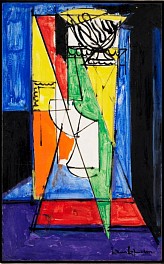BIOGRAPHY

German-American (1880-1966)
Hans Hofmann was a German-born American painter, renowned as both an artist and teacher. His career spanned two generations and two continents, and is considered to have both preceded and influenced Abstract Expressiobism. Born and educated near Munich, he was active in the early twentieth-century European avant-garde and brought a deep understanding and synthesis of Symbolism, Neo-impressionism, Fauvism, and Cubism when he emigrated to the United States in 1932. Hofmann's painting is characterized by its rigorous concern with pictorial structure and unity, spatial illusionism, and use of bold color for expressive means.
The influential critic Clement Greenburg considered Hofmann's first New York solo show at Peggy Guggenheims Art of This Century Gallery in 1944 (along with Jackson Pollock's in late 1943) as a breakthrough in painterly versus geometric abstraction that heralded abstract expressionism. In the decade that followed, Hofmann's recognition grew through numerous exhibitions, notably at the Kootz culminating in major retrospectives at the Whitney (1957) and MOMA (1963). His works are in the permanent collections of major museums around the world, including the Metropolitan Museum of Art, the National Gallery6 and the Art Institute of Chicago, among others.
Hofmann is also regarded as one of the most influential art teachers of the 20th century. He established an art school in Munich in 1915 that built on the ideas and work of Cezanne, the Cubists and Kandinsky; some art historians suggest it was the first modern school of art anywhere. After relocating to the United States, he reopened the school in both New York City and Provincetown, Massachusetts until he retired from teaching in 1958 to paint full-time. His presence in New York teaching had a significant influence on post-war American avant-garde artists—including Helen Frankenthaler, Nell Blaine, Lee Krasner, Joan Mitchell, Louisee Nevelson and Larry Rivers among many—as well as on the theories of Greenberg, in his emphasis on the medium, picture plane, and unity of the work. Some of Hofmann's other key tenets include his push/pull spatial theories, his insistence that abstract art has its origin in nature, and his belief in the spiritual value of art.
Hoffman worked his way across nearly the entire wide swath of Modernism over his 60+ year career. From early pointillist self portraits, he worshiped at the altar of Cezanne's perspective-tilting interiors, dove into Picasso’s Cubism, sampled from Liubov Popova's Supremitism, and actually beat Jackson Pollock to action-painting in a series of drip paintings Hoffman splashed out in the 1940s. Yet, one constant was color--emerald blues, yellows, reds and greens: Dialogs between colors. Colors as spaces, like woods and fields and moonlit lakes viewed from high above.
The art world likes for an artist to be known for a particular style, but Hofmann refused to be pigeon-holed. He writes: "What I would hate most is to repeat myself over and over again - to develop a false style. I do not want to avoid immersing myself in trouble - to be in a mess - to struggle out of it. I want to invent, to discover, to imagine, to speculate, to improvise - to seize the hazardous in order to be inspired. I want to experience the manifestation of the absolute - the manifestation of the unexpected in an extreme and unique relation. I know that only by following my creative instincts in an act of creative destruction will I be able to find it."
